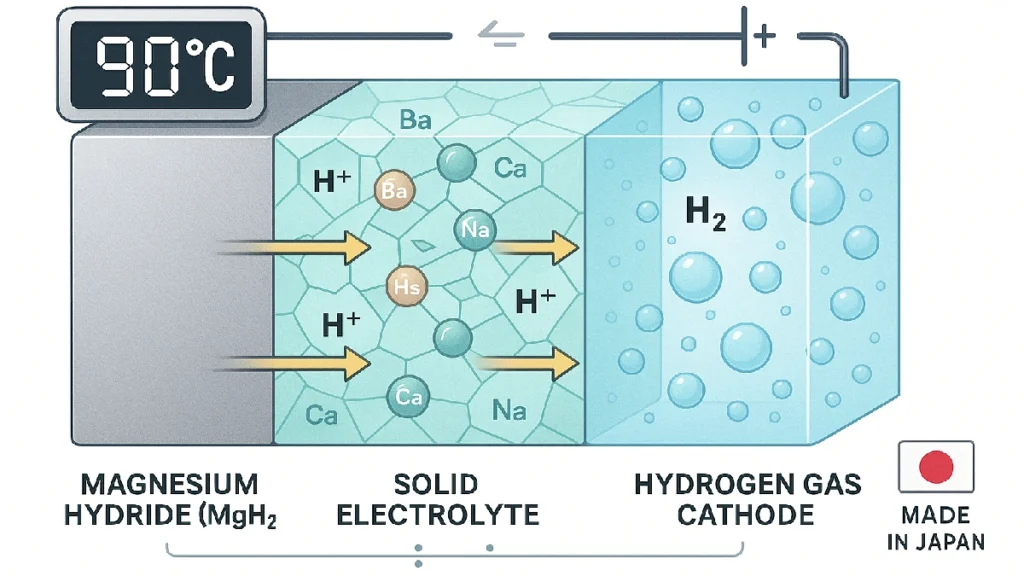The hydrogen economy has long been shackled by a fundamental physics problem that seemed almost insurmountable. Now, Japanese researchers have achieved what many considered impossible: a hydrogen battery that operates at a mere 90°C, shattering the 300-400°C barrier that has kept hydrogen storage in the realm of laboratory curiosities rather than practical energy solutions.

This isn’t just an incremental improvement—it’s a complete reimagining of how hydrogen can be stored and released, with implications that could reshape everything from electric vehicles to industrial energy storage.
The Fundamental Physics Behind the Breakthrough
To understand why this discovery is revolutionary, we must examine hydrogen storage at its most basic level. Traditional solid-state hydrogen storage relies on metal hydrides like magnesium hydride (MgH₂), which can theoretically store massive amounts of hydrogen—up to 7.6% by weight. However, the thermal approach to releasing this stored hydrogen requires breaking chemical bonds through brute force heating, demanding temperatures exceeding 300°C.
The Japanese team at the Institute of Science Tokyo fundamentally changed this approach by switching from thermal to electrochemical processes. Instead of using heat to break bonds, they engineered a system that uses electrical energy to orchestrate the precise movement of hydride ions (H⁻) through a specially designed crystal lattice.
The key innovation lies in their solid electrolyte material: Ba₀.₅Ca₀.₃₅Na₀.₁₅H₁.₈₅. This compound features an anti-α-AgI-type crystal structure where barium, calcium, and sodium atoms occupy fixed body-centered positions, while hydride ions can migrate freely through face-sharing tetrahedral and octahedral sites. This atomic architecture creates highways for ion transport that function efficiently at dramatically lower temperatures.
The Electrochemical Dance of Hydrogen Storage
During operation, this battery orchestrates a precisely choreographed atomic dance. When charging, magnesium hydride at the anode releases hydride ions, which then migrate through the crystal highways of the solid electrolyte to reach the hydrogen gas cathode, where they’re oxidized to release H₂ gas. During discharge, the process reverses: hydrogen gas molecules are reduced back to hydride ions, which travel back through the electrolyte to react with magnesium and reform MgH₂.
This electrochemical approach achieves something remarkable: the full theoretical storage capacity of magnesium hydride—2,030 mAh/g—over repeated cycles at temperatures below 100°C. The solid electrolyte demonstrates impressive ionic conductivity of 2.1 × 10⁻⁵ S cm⁻¹ at room temperature, enabling efficient operation without the energy penalty of extreme heating.
Breaking the Energy Penalty Barrier
The temperature reduction from 300-400°C to 90°C represents more than convenience—it eliminates a massive energy penalty that made previous hydrogen storage systems impractical. Operating at near-boiling water temperatures means this technology can integrate seamlessly with existing thermal management systems in vehicles and industrial applications, rather than requiring specialized high-temperature materials and insulation.
The crystalline structure’s stability ensures the system maintains performance over multiple charge-discharge cycles without the degradation that plagued earlier liquid electrolyte approaches. This durability, combined with the safety advantages of solid-state operation, creates a viable pathway for hydrogen to compete with lithium-ion batteries in demanding applications.
Industrial and Transport Applications
The implications extend far beyond laboratory demonstrations. This technology enables practical hydrogen-powered vehicles by eliminating the need for cryogenic storage at -252.8°C or extreme pressure systems operating at 350-700 bar. Instead, hydrogen can be stored in a solid-state battery system that operates within the thermal envelope of conventional automotive cooling systems.
For grid-scale energy storage, the ability to repeatedly cycle large quantities of hydrogen at manageable temperatures opens new possibilities for seasonal energy storage and industrial applications where hydrogen serves as both fuel and chemical feedstock. The technology aligns perfectly with Japan’s strategic push toward a “hydrogen society” and provides a technical foundation for scaling hydrogen infrastructure globally.




